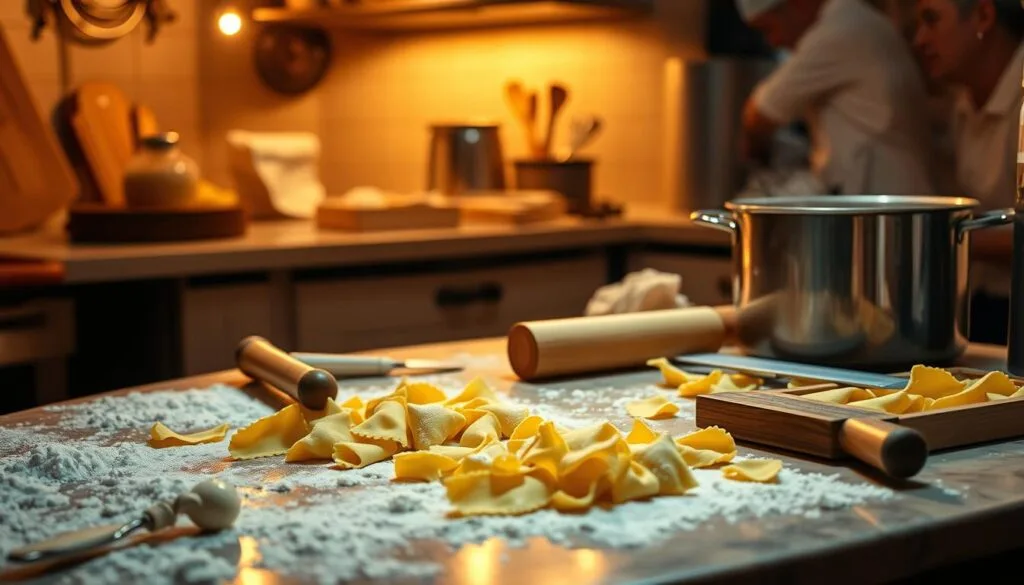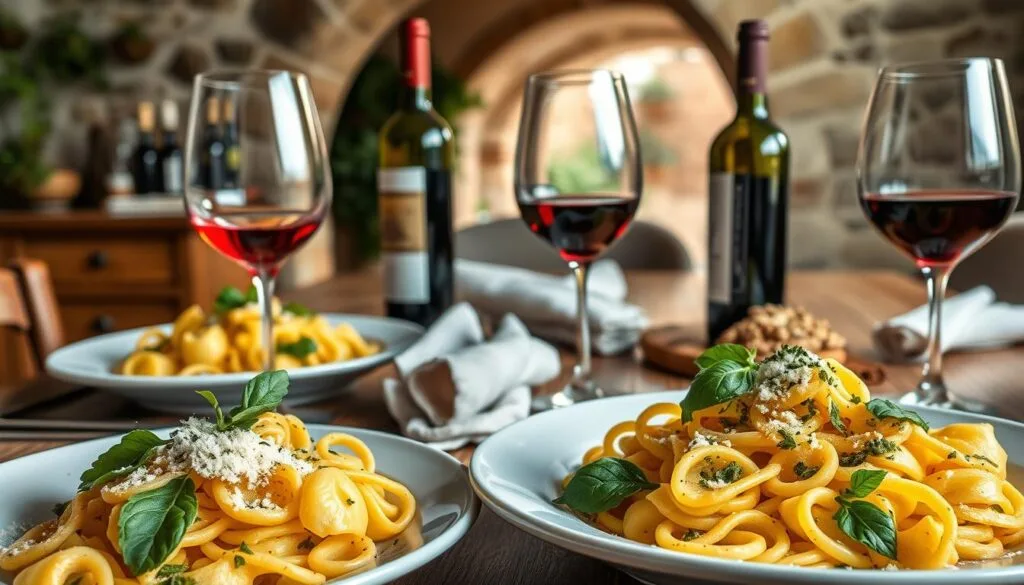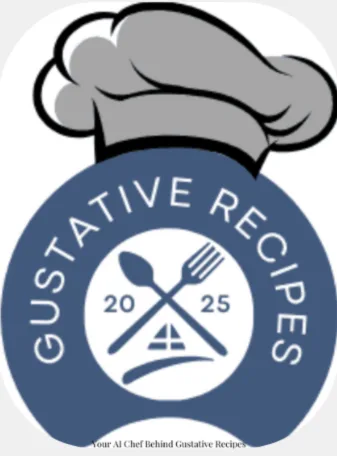There’s something magical about shaping dough into little ridges and curves with your own hands. This is what draws me to Italian pasta recipe traditions like DELICIOUS HOMEMADE CAVATELLI. Growing up, my kitchen was always filled with the scent of semolina flour and the soft clink of rolling pins.
These tools turned simple ingredients into something nourishing. Now, I see how those moments of rolling out dough or pinching pasta shapes created more than just food; they built memories.
Authentic pasta dishes like cavatelli aren’t just about technique—they’re about connection. Whether you’re making them for a quiet dinner or a festive table, these small noodles carry stories. This guide will walk you through transforming semolina and water into something tender and personal.
No need for fancy tools or years of practice—we’ll keep it simple, step by step. Let’s turn your kitchen into a space where tradition meets joy, one handmade noodle at a time.
What is Cavatelli?
Cavatelli is a pasta with a rich history. It’s a symbol of tradition in Southern Italy. Traditional pasta making was a weekly event in these sunlit kitchens. This pasta connects us to the heart of Italian cuisine.
A Brief History of Cavatelli
Cavatelli comes from Abruzzo and Apulia. It’s a mix of simplicity and creativity. Grandmothers made it by hand, a tradition still loved today.
The name “cavatelli” means “hollow.” It describes the way the pasta holds sauce. This pasta was more than food; it was a family treasure.
The Difference Between Cavatelli and Other Pasta Types
So, what makes cavatelli special? Let’s look:
- Shape: Its ridges and curves trap sauce, unlike smooth spaghetti.
- Texture: It’s light yet sturdy, perfect for hearty dishes.
| Pasta Type | Shape | Sauce Pairing |
|---|---|---|
| Cavatelli | Ridged crescent | Chunky tomato or pesto |
| Spaghetti | Smooth cylinder | Light olive oil or marinara |
| Rigatoni | Tube with ridges | Meat-based sauces |
Every bite of cavatelli tells a story of Italian cuisine. It’s shaped by history and tradition. Are you ready to learn how to make it? Let’s look at the ingredients next.
Ingredients for DELICIOUS HOMEMADE CAVATELLI
Every great dish starts with simple ingredients, and cavatelli is no exception. Think of your pantry as a cozy kitchen garden—everything you need is already there, waiting to become something magical. Let’s break down what makes homemade pasta dough so special.
Essential Ingredients You’ll Need
- “00” flour: The star of our fresh pasta foundation, giving the dough its silky texture.
- Eggs: Nature’s binder, holding the dough together with golden warmth.
- Salt: A pinch to awaken the flavors, just like a hug for your ingredients.
- Semolina flour (optional, but a pro tip for drying shaped pasta).
Optional Add-ins for Flavor
Here’s where creativity shines. Try these gentle upgrades:
- Herbs: A sprinkle of basil or rosemary whispers of Italian gardens into your pasta from scratch.
- Spinach purée: Turn your dough green—like spring in every bite.
- Olive oil: Adds richness without overwhelming the dish.
“Adding a dash of nutmeg once gave my cavatelli a cozy, nostalgic taste—like my Nonna’s kitchen.”
Remember, even a pinch of experimentation is enough. Trust your instincts, and let your ingredients tell their story. After all, fresh pasta is about joy, not perfection.
Tools and Equipment Needed
Your kitchen is likely stocked with what you need for traditional pasta making. Whether you’re following an Italian recipe or trying new shapes, keep it simple. A wooden board, fork, and rolling pin are all you need to make tender cavatelli.
Kitchen Equipment to Make Cavatelli
Here’s what you’ll use most:
- A smooth cutting board or pasta board for kneading dough
- A fork or specialized cavatelli tool for shaping
- A clean kitchen towel to keep dough from drying out
A basic rolling pin is perfect—no need for a machine unless you make pasta often. As the New York Magazine Strategist notes, basic tools are often all you need for great results.
Helpful Tools for Shaping Pasta
A fork is my top choice. Its ridges press into dough like a cavatelli tool, creating those signature ridges. If you’re interested in specialized gear, a wooden pasta board with indentations is a good investment. It connects you to traditional pasta making traditions.
But remember, your hands are your best tool. I’ve made pasta with just a plate and butter knife, and it was delicious. Every pot and pan in your kitchen has a role. A colander for draining, a large pot for boiling, and even a spoon for tossing sauce are all part of the ritual. Start simple. The joy of homemade pasta is in the process, not the tools.
Step-by-Step Guide to Making Cavatelli
Start your Homemade Cavatelli journey with gentle hands and open curiosity. This pasta from scratch is a labor of love. Take your time—every fold and press matters.
Mixing the Dough
Begin by whisking 2 cups of flour and a pinch of salt. Make a well, then crack in 3 eggs. Slowly pull the flour into the yolks.
Knead until the dough feels silky but firm. This is your canvas for creativity. If it’s too sticky, dust with flour. Too dry? A drop of water can balance it.
Shaping the Cavatelli
Divide the dough into portions. Roll each piece thin, then cut into 1-inch bits. Here’s how to shape them:
| Step | Action | Tip |
|---|---|---|
| 1 | Pinch dough between thumb and fork | Press lightly, letting ridges form naturally |
| 2 | Roll pieces forward on the fork | Think of it as a gentle dance between tool and dough |
Cooking the Cavatelli
Bring salted water to a rolling boil. Add shaped pasta and stir gently. Watch as they pirouette—when they float, they’re done.
Taste a piece to check for al dente perfection. Drain, then toss in sauce right away.
Remember: imperfections are part of the charm. Each bump and curve tells a story of your care. Happy shaping!
Popular Sauces to Pair with Cavatelli
Once your cavatelli is ready, it’s time to find the perfect sauce. Italian cuisine has many options, each one enhancing the pasta’s flavor. Let’s look at some flavors that make your homemade cavatelli a true masterpiece.
Classic Tomato Sauce
This sauce is a tribute to tradition. It’s made with slow-cooked tomatoes, garlic, and rosemary. A drizzle of extra-virgin olive oil adds a special touch. The cavatelli’s ridges perfectly hold the sauce, just like Nonna taught.
Creamy Alfredo Sauce
This sauce is rich and smooth, like a warm hug. It’s made with fresh parmesan, butter, and cream. Adding a bit of lemon zest lightens it up. It’s the ultimate comfort food.
Pesto Options
Pesto is like a summer day in a bowl. Classic basil pesto is a favorite, with garlic and pine nuts. Try sun-dried tomato pesto for depth or walnut pesto for a nutty twist. The cavatelli’s ridges catch every herb.
| Sauce | Flavor Profile | Pairing Tip |
|---|---|---|
| Classic Tomato | Tomato-forward with herbal depth | Top with fresh basil leaves and grated pecorino. |
| Creamy Alfredo | Creamy and savory with dairy richness | Finish with cracked black pepper for contrast. |
| Herb Pesto | Herby, bright, and slightly peppery | Stir in roasted red peppers for a modern touch. |
Tips for Perfect Cavatelli Every Time
Mastering traditional pasta making takes time and effort. Even I’ve had my share of pasta-making mishaps. My dough was too sticky at first, but I learned how to fix it. Let’s go over some common problems together.

Common Mistakes to Avoid
| Mistake | Fix |
|---|---|
| Overkneading the dough | Knead just until smooth—8-10 minutes max. |
| Ignoring resting time | Let dough rest 20-30 minutes to relax gluten. |
| Rushing shaping | Patience! Roll slowly to avoid tearing delicate dough. |
How to Achieve the Right Texture
- Check dough softness: It should feel like a baby’s cheek—supple but not sticky.
- Shape test: Pinch edges gently; they should hold without crumbling.
- Cook briefly: 2-4 minutes in salted water—al dente is key.
My early tries at pasta from scratch were a bit rough. But I learned that texture is all about finding the right balance. If the dough feels too dry, just add a little water. And don’t forget, having the right ingredients on hand helps a lot. For quick fixes, check out easy pantry staples to keep on hand.
With these tips, your cavatelli will turn out great. Remember, practice makes progress, and every mistake is a chance to learn. You’ve got this!
Storing and Freezing Homemade Cavatelli
Keeping your homemade cavatelli fresh starts with good storage. Whether you’re saving for tomorrow or freezing for later, these tips help. They keep your pasta fresh and tender. Here’s how to maintain that homemade touch:
Best Practices for Storage
For fresh pasta to cook in 2–3 days:
- Spread cavatelli on a clean kitchen towel to air-dry for 15 minutes.
- Layer in an airtight container with parchment paper between layers.
- Keep refrigerated—store in the crisper drawer for best results.
How to Freeze Cavatelli for Later Use
Freezing extends the joy of homemade flavors for months. Try this method:
- Let cavatelli dry completely on a wire rack.
- Divide into meal-sized portions and seal in freezer bags.
- Label with dates and thaw overnight in the fridge before cooking.
| Method | Steps | Notes |
|---|---|---|
| Refrigeration | Air-dry then layer in containers | Use within 3 days |
| Freezing | Portion and freeze flat | Keeps up to 3 months |
Pro tip: Freeze uncooked or cooked pasta—both stay great. Think of storage as a kind act to your future self. It ensures every bite is as special as the day it was made.
Nutritional Benefits of Cavatelli
When we make homemade cavatelli, we’re not just making pasta. We’re taking care of our bodies and souls. Italian pasta recipe traditions like this dish offer more than just comfort. They’re made with ingredients that can help keep us healthy.
Healthy Ingredients for a Balanced Meal
Simple ingredients make up cavatelli:
- Whole wheat flour adds fiber and slow-burning carbs.
- Eggs provide protein and vitamins to keep you energized.
- Hand-rolled shapes let you sneak veggies like spinach or squash into the dough for extra nutrients.
Adding fresh herbs or roasted veggies as toppings boosts flavor and vitamins without added sugars or preservatives.
Nutritional Value Compared to Other Pastas
Homemade cavatelli is healthier than boxed pasta, especially when made with whole grains or alternative flours. Here’s why:
- Authentic pasta dishes avoid additives found in store-bought options.
- You control salt and fat content—like using olive oil instead of butter.
- Smaller portion sizes when made fresh mean mindful eating.
“Pasta’s reputation as ‘unhealthy’ often stems from portion sizes, not the dish itself. A well-made Italian pasta recipe can be part of a vibrant, varied diet,” says nutritionist Elena Marconi, founder of Mindful Bites.
We believe nourishment comes from both fuel and joy. Whether you choose whole grains or seasonal toppings, cavatelli becomes a canvas for creativity. It honors your health and your cravings. The best meals are those that sustain us physically and bring people together emotionally.
Serving Suggestions for Cavatelli
Sharing a plate of cavatelli with loved ones is special. In Italian cuisine, food is a way to show love. It’s perfect for cozy dinners or big gatherings. Here’s how to make it stand out.

Creative Ways to Serve Cavatelli
Cavatelli is like a blank canvas. Here are some ideas to make it yours:
- Top with a citrus-garlic sauce and toasted pine nuts for a light spring meal.
- Layer with roasted cherry tomatoes, basil, and a drizzle of balsamic glaze.
- Add a protein boost with pan-seared shrimp or crispy prosciutto slices.
“The best meals are the ones where the table becomes a story. I’ll never forget the time my family added wild mushrooms to our cavatelli—it turned a weeknight dinner into a celebration.”
Cavatelli Variations Around the World
Every bite of cavatelli tells a story. In Italy, pasta shapes change with the land and the hands that make them. In Puglia, the sun-bleached hills inspire ridged cavatelli made with a wooden knife.
Head north to Abruzzo, where fingers press dimples into dough. This tradition is as old as the olive groves. These Italian cuisine traditions are more than recipes; they’re love letters to place and memory.
Regional Specialties in Italy
- Puglia’s orecchiette (“little ears”) cradle robust tomato sauces
- Abruzzo’s cavatelli alla pescocotto pair with gamey wild boar ragu
- Sicilian cooks shape them larger to hold nutty almond-based sauces
Unique Takes in American Cuisine
In New York’s Little Italy, nonna’s recipes merged with new ingredients. Today, kitchens blend traditions. For example, creamy sausage sauces meet cavatelli’s nooks.
Chefs experiment, adding spinach for vibrant green spirals or mixing in heritage grains. Yet, the core remains the same. It’s the same nurturing spirit that crossed oceans.
Whether hand-rolled in Calabria or baked into casserole form in Chicago, cavatelli’s story is one of adaptation. It grows without forgetting where it began. Next time you shape dough, think of those hands before yours—your version is just as valid.
Cavatelli and Cultural Significance
Imagine sitting at a sunlit kitchen table, rolling dough between calloused hands. This is the heart of traditional pasta making. It’s a ritual that connects generations. For many families, making Cavatelli is more than cooking; it’s sharing stories.
We’ve seen grandmothers teach grandchildren to press thumbprints into dough. They turn Italian pasta recipe techniques into family treasures. These moments are not just about food; they weave together a cultural tapestry.
Family Traditions Involving Cavatelli
Rolling pasta by hand is a special tradition in southern Italian homes. It’s a rite of passage. Here’s how it continues:
- Grandparents share stories while kneading dough
- Children learn to shape ridges that hold sauce
- Recipes are written in old cookbooks
Cavatelli in Celebrations and Holidays
At holiday tables, Cavatelli symbolizes togetherness. Imagine Italian pasta recipe served at Christmas, its curves holding rich ragù. Or Easter lunches with Cavatelli tossed with spring herbs.
These dishes are more than meals; they’re expressions of love for heritage. Even if your roots aren’t Italian, you can start your own traditions. Add a slice of your culture to the dough. Making it by hand turns Cavatelli into a universal language of care.
Conclusion: Enjoying Your Homemade Cavatelli
Making Homemade Cavatelli is more than just pasta. It’s a tradition that connects you to your family’s past. Every step, from kneading to shaping, is a warm touch of tradition.
Recap of Key Points
Starting with flour and eggs is the heart of making pasta. You’ve learned how to turn simple ingredients into fresh pasta. Tools like a fork or cavatelli board add a personal touch. And, cooking it right makes it tender.
Storing or freezing leftovers means you can enjoy it later. This keeps the joy alive even after your first try.
Encouragement for Readers to Try Making Cavatelli
Let this recipe be your own story. The kitchen is where small efforts lead to big rewards. Each bite is a source of pride, whether with tomato sauce or pesto.
You don’t need fancy tools to make Homemade Cavatelli. Just curiosity and patience. It’s a way to nourish yourself, one ball of dough at a time.
When you make Homemade Cavatelli, you’re creating something special. It’s a quiet act of self-care. Let your hands remember the dough’s rhythm and your heart enjoy the flavors of tradition. Your kitchen is waiting—what will your cavatelli taste like?
We are interested in your feedback
There are no reviews yet. Be the first one to write one.

